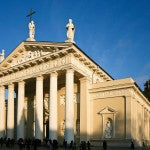Even though Rococo architecture managed to spread beyond its country of origin, it met its decline relatively early, fading out as both an art and an architecture movement within a few decades. Artists and architects needed to move on from the flamboyant to the somber and timeless. They needed a new movement. And for that, they looked to the past.
A look into the Greco-Roman period provided the basis for this new architectural movement. Inspired by the classical antiquity, neoclassicism rose. Church architecture adopted the neoclassical style as a result.
Neoclassical architecture drew upon structures of the ancient world. This evident in the hulking façade and columns of many buildings. It persisted up until the 21st century, proving its timelessness well into modern times, though buildings made in this style in recent times are more formally known as New Classical Architecture.
Here are some features of neoclassical architecture.
Shape
 The New York Public Library. Image source: Virtual Tourist
The New York Public Library. Image source: Virtual Tourist
Symmetrical shapes made up the many buildings during the time, a stark contrast to Rococo's focus on asymmetry and flowing, organic shapes. The period saw a return to simple geometric forms such as round arches, while indulging in more ornate, yet still geometric, methods of ornamentation.
Columns
 Various types of architectural columns. Image source: Wikipedia
Various types of architectural columns. Image source: Wikipedia
Prominent, particularly in facades, were columns inspired by those in use during the Romanesque period, which in turn were inspired by column designs from Ancient Rome and Greece. The main aesthetic difference is that neoclassical columns tended to favor more dramatic columns such as the Corinthian order featured in the example of the New York Public Library above, while Romanesque columns favored simpler orders such as the Doric and Tuscan. The columns of the Neoclassic Era often reached the full height of buildings.
Pediments
 Image source: Flickr
Image source: Flickr
Resembling ancient landmarks, pediments were triangular in appearance. Unlike the Romanesque counterparts, elaborate decorations adorned the pediments up front.
Roofs
 Image source: Architecture Styles
Image source: Architecture Styles
Domes were present in roofs of neoclassical buildings, but aren't usually visible when viewing the façade. The best way to view the domes is from the inside of the structure.
Examples of Neoclassical Architecture
Cathedral of Vilnius, Lithuania(1783 AD)
 Image source: Wikipedia
Image source: Wikipedia
Benghazi Cathedral, Libya (1939 AD)
 Image source: Panoramio
Image source: Panoramio
Basilica di San Marino, Italy (1838 AD)
 Image source: Virtual Tourist
Image source: Virtual Tourist
St. Stephen’s Basilica, Hungary (1905 AD)
 Image source: Budapest Locals
Image source: Budapest Locals
Unlike other movements, neoclassicism lasted centuries. Factors of neoclassical art and architecture are still in use today. Elements of neoclassicism remained untouchedm despite the rise of modernity. And even after other movements rose, neoclassicism was never forgotten.
Later in the 19th century, the neoclassical movement went hand-in-hand with the Romantic Movement. The latter was more focused on art instead of architecture. And by the end of the century was the dawn of the modern era.
A new architectural movement was on the rise once again. It was an effort to incorporate current architectural styles with technological advancements.
The Modernist movement was then born. Its influence is still evident in today’s society.
We will talk about Modernist architecture in the next blog post.


